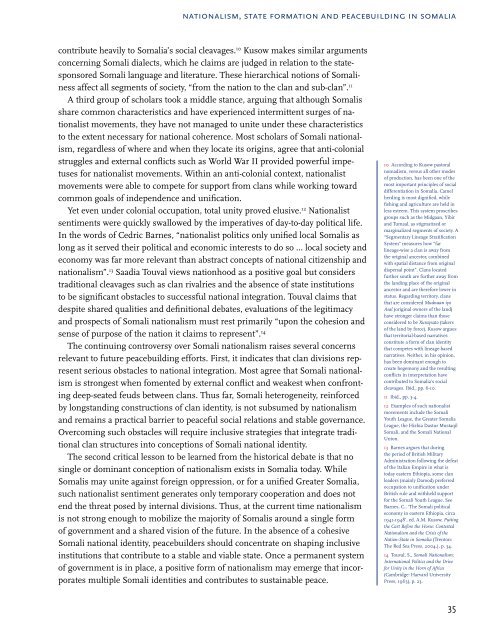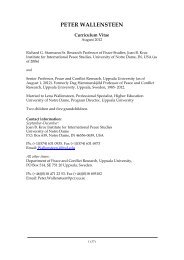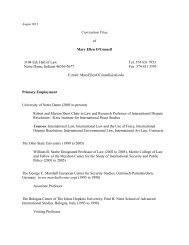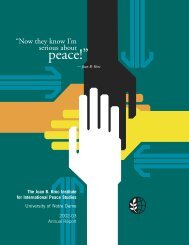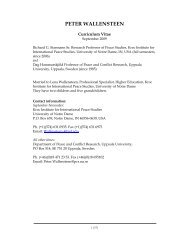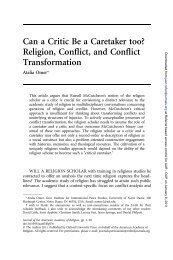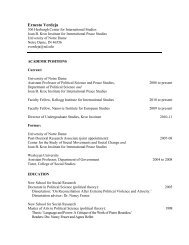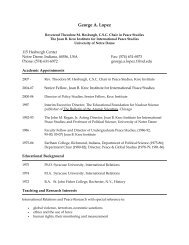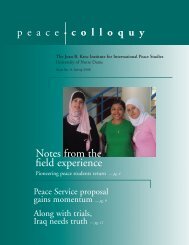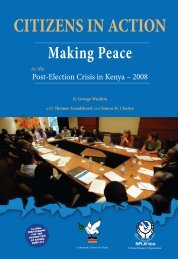Somalia: Creating Space for Fresh Approaches to Peacebuilding
Somalia: Creating Space for Fresh Approaches to Peacebuilding
Somalia: Creating Space for Fresh Approaches to Peacebuilding
Create successful ePaper yourself
Turn your PDF publications into a flip-book with our unique Google optimized e-Paper software.
nationalism, state <strong>for</strong>mation and peacebuilding in somalia<br />
contribute heavily <strong>to</strong> <strong>Somalia</strong>’s social cleavages. 10 Kusow makes similar arguments<br />
concerning Somali dialects, which he claims are judged in relation <strong>to</strong> the statesponsored<br />
Somali language and literature. These hierarchical notions of Somaliness<br />
affect all segments of society, “from the nation <strong>to</strong> the clan and sub-clan”. 11<br />
A third group of scholars <strong>to</strong>ok a middle stance, arguing that although Somalis<br />
share common characteristics and have experienced intermittent surges of nationalist<br />
movements, they have not managed <strong>to</strong> unite under these characteristics<br />
<strong>to</strong> the extent necessary <strong>for</strong> national coherence. Most scholars of Somali nationalism,<br />
regardless of where and when they locate its origins, agree that anti-colonial<br />
struggles and external conflicts such as World War II provided powerful impetuses<br />
<strong>for</strong> nationalist movements. Within an anti-colonial context, nationalist<br />
movements were able <strong>to</strong> compete <strong>for</strong> support from clans while working <strong>to</strong>ward<br />
common goals of independence and unification.<br />
Yet even under colonial occupation, <strong>to</strong>tal unity proved elusive. 12 Nationalist<br />
sentiments were quickly swallowed by the imperatives of day-<strong>to</strong>-day political life.<br />
In the words of Cedric Barnes, “nationalist politics only unified local Somalis as<br />
long as it served their political and economic interests <strong>to</strong> do so … local society and<br />
economy was far more relevant than abstract concepts of national citizenship and<br />
nationalism”. 13 Saadia Touval views nationhood as a positive goal but considers<br />
traditional cleavages such as clan rivalries and the absence of state institutions<br />
<strong>to</strong> be significant obstacles <strong>to</strong> successful national integration. Touval claims that<br />
despite shared qualities and definitional debates, evaluations of the legitimacy<br />
and prospects of Somali nationalism must rest primarily “upon the cohesion and<br />
sense of purpose of the nation it claims <strong>to</strong> represent”. 14<br />
The continuing controversy over Somali nationalism raises several concerns<br />
relevant <strong>to</strong> future peacebuilding ef<strong>for</strong>ts. First, it indicates that clan divisions represent<br />
serious obstacles <strong>to</strong> national integration. Most agree that Somali nationalism<br />
is strongest when fomented by external conflict and weakest when confronting<br />
deep-seated feuds between clans. Thus far, Somali heterogeneity, rein<strong>for</strong>ced<br />
by longstanding constructions of clan identity, is not subsumed by nationalism<br />
and remains a practical barrier <strong>to</strong> peaceful social relations and stable governance.<br />
Overcoming such obstacles will require inclusive strategies that integrate traditional<br />
clan structures in<strong>to</strong> conceptions of Somali national identity.<br />
The second critical lesson <strong>to</strong> be learned from the his<strong>to</strong>rical debate is that no<br />
single or dominant conception of nationalism exists in <strong>Somalia</strong> <strong>to</strong>day. While<br />
Somalis may unite against <strong>for</strong>eign oppression, or <strong>for</strong> a unified Greater <strong>Somalia</strong>,<br />
such nationalist sentiment generates only temporary cooperation and does not<br />
end the threat posed by internal divisions. Thus, at the current time nationalism<br />
is not strong enough <strong>to</strong> mobilize the majority of Somalis around a single <strong>for</strong>m<br />
of government and a shared vision of the future. In the absence of a cohesive<br />
Somali national identity, peacebuilders should concentrate on shaping inclusive<br />
institutions that contribute <strong>to</strong> a stable and viable state. Once a permanent system<br />
of government is in place, a positive <strong>for</strong>m of nationalism may emerge that incorporates<br />
multiple Somali identities and contributes <strong>to</strong> sustainable peace.<br />
10 According <strong>to</strong> Kusow pas<strong>to</strong>ral<br />
nomadism, versus all other modes<br />
of production, has been one of the<br />
most important principles of social<br />
differentiation in <strong>Somalia</strong>. Camel<br />
herding is most dignified, while<br />
fishing and agriculture are held in<br />
less esteem. This system proscribes<br />
groups such as the Midgaan, Yibir<br />
and Tumaal, as stigmatized or<br />
marginalized segments of society. A<br />
“Segmentary Lineage Stratification<br />
System” measures how “far<br />
lineage-wise a clan is away from<br />
the original ances<strong>to</strong>r, combined<br />
with spatial distance from original<br />
dispersal point”. Clans located<br />
further south are further away from<br />
the landing place of the original<br />
ances<strong>to</strong>r and are there<strong>for</strong>e lower in<br />
status. Regarding terri<strong>to</strong>ry, clans<br />
that are considered Mudnaan iyo<br />
Asal (original owners of the land)<br />
have stronger claims than those<br />
considered <strong>to</strong> be Xuraysa<strong>to</strong> (takers<br />
of the land by <strong>for</strong>ce). Kusow argues<br />
that terri<strong>to</strong>rial-based narratives<br />
constitute a <strong>for</strong>m of clan identity<br />
that competes with lineage-based<br />
narratives. Neither, in his opinion,<br />
has been dominant enough <strong>to</strong><br />
create hegemony and the resulting<br />
conflicts in interpretation have<br />
contributed <strong>to</strong> <strong>Somalia</strong>’s social<br />
cleavages. Ibid., pp. 6-10.<br />
11 Ibid., pp. 3-4.<br />
12 Examples of such nationalist<br />
movements include the Somali<br />
Youth League, the Greater <strong>Somalia</strong><br />
League, the Hizbia Dastur Mustaqil<br />
Somali, and the Somali National<br />
Union.<br />
13 Barnes argues that during<br />
the period of British Military<br />
Administration following the defeat<br />
of the Italian Empire in what is<br />
<strong>to</strong>day eastern Ethiopia, some clan<br />
leaders (mainly Darood) preferred<br />
occupation <strong>to</strong> unification under<br />
British rule and withheld support<br />
<strong>for</strong> the Somali Youth League. See<br />
Barnes, C., ‘The Somali political<br />
economy in eastern Ethiopia, circa<br />
1941-1948’, ed. A.M. Kusow, Putting<br />
the Cart Be<strong>for</strong>e the Horse: Contested<br />
Nationalism and the Crisis of the<br />
Nation-State in <strong>Somalia</strong> (Tren<strong>to</strong>n:<br />
The Red Sea Press, 2004.), p. 34.<br />
14 Touval, S., Somali Nationalism:<br />
International Politics and the Drive<br />
<strong>for</strong> Unity in the Horn of Africa<br />
(Cambridge: Harvard University<br />
Press, 1963), p. 23.<br />
35


